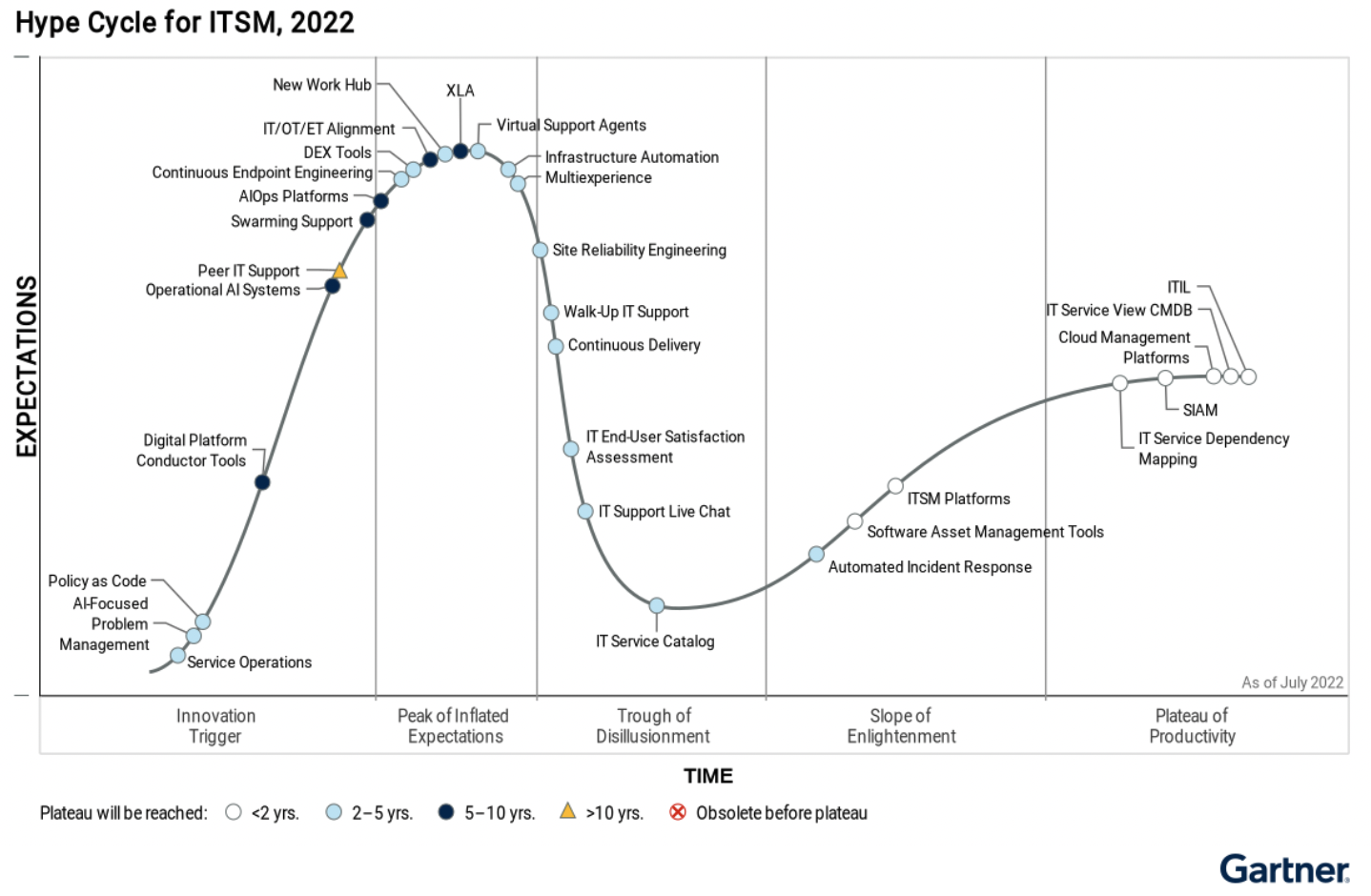Gartner® published its “Hype Cycle for ITSM, 2022,” showing what’s hitting peak inflated expectation (e.g., XLA), what’s in the Trough of Disillusionment (e.g., IT Service Catalogs), and where productivity is plateauing (e.g., Cloud Management Platforms). But what’s that at the very beginning of the Innovation Trigger category?* Take a look:

Is that ServiceOps? Yes, it is. Gartner spells it out as “Service Operations,” which is primed to reach a plateau in two to five short years based on the chart above.
What is ServiceOps?
The Gartner definition: “Service Operations is the convergence of the infrastructure and application monitoring environments with the ITSM incident management practice to create a quicker and more effective mechanism for diagnosing and resolving incidents. The combination of the two environments with the context of AI can lead to a significant reduction in both the number and impact of incidents.”
Why is it important?
According to Gartner, “The ability to quickly diagnose and resolve incidents is becoming paramount for many organizations as they develop and implement digital services.”
No one likes downtime or poor application/service performance, so being able to sort out problems or potential issues quickly is of utmost importance. Organizations have been doing this for years, but in a service management silo or an operations management silo.
A recent survey conducted by Hanover Research on BMC’s behalf shows that 73 percent of large enterprises are combining operations and service management teams into one. This has trended upward over the last three years since the survey was first commissioned. Now, from a technology perspective, these two historically distinct functions are truly coming together.
What’s the business impact?
Gartner states it well: “The convergence of ITSM and the various monitoring environments results in a more productive and seamless incident management practice. The contextual analysis of alerts with recent activity associated with the CI can result in fewer incidents and improved mean time to repair (MTTR) for those that do occur. Products and services are more available and less likely to suffer from poor performance or outages and disruption, and costs are reduced, and overall productivity is improved.”
BMC’s approach to ServiceOps
A number of years ago, when we launched the Helix brand that brought our service management and operations management offerings together under one name, the aim was to bring the data and information from these tools together to help our customers solve problems faster. When this became a technical reality about a year ago, we termed it ServiceOps.
We believe that managing large, increasingly complex, and heterogeneous environments requires a holistic approach to service and operations management. BMC’s unique ServiceOps solution unifies the data from Operations Management, Service Management, and third-party tools with dynamic service models, using AI and machine learning to help find and solve problems faster, support high-velocity DevOps teams better, and connect the lines of business.
Considered separately, our BMC Helix ITSM, BMC Helix Operations Management, and BMC Helix Discovery solutions offer great value and capabilities to customers, but the real magic occurs when they come together to power ServiceOps.
We’ve built BMC Helix to natively bring together the power of these solutions, enabling them to share service models, performance data, service metrics, third-party data, and more to better ensure services perform the way they were designed at all times for optimized user and employee experiences. The ServiceOps capabilities of BMC Helix are unmatched, helping organizations reduce risk, lower costs, and increase efficiency and productivity.
It’s all about the AI and service models
The core of our ServiceOps approach is embedded AI and dynamic service modeling capabilities. In its explanation of Service Operations, Gartner warns of two things:
- “AI-based monitoring systems can take a long time to understand the context of the environment.
- Accurate service mapping and comprehensive CMDBs are necessary to support the end-to-end incident process.”
We agree these are important cautions and something we’re actively helping customers avoid.
Our AI models are pre-trained on extensive real-world customer data (all opt-in and anonymized, of course) so that they come ready to go out of the proverbial box. This allows customers to immediately see value with no manual steps or domain knowledge needed, and find problems quicker from the start, without having to get through a break-in period.
And our dynamic service modeling capabilities provide a complete and up-to-date view of your IT assets and relationships. To make it more useful, it provides a business service perspective instead of individual assets, tiers, applications, et al. This gives customers a holistic view of the business service environment so they can visualize business health, understand the impact of problems on the business, and enable root cause isolation to fix those problems fast.
It’s an exciting time for the BMC Helix portfolio and our approach to ServiceOps. And we believe the rest of the industry is starting to take notice.
* Gartner, Hype Cycle for ITSM, 2022, Siddharth Shetty, July 13, 2022.
Gartner does not endorse any vendor, product or service depicted in its research publications, and does not advise technology users to select only those vendors with the highest ratings or other designation. Gartner research publications consist of the opinions of Gartner’s research organization and should not be construed as statements of fact. Gartner disclaims all warranties, expressed or implied, with respect to this research, including any warranties of merchantability or fitness for a particular purpose.
This graphic was published by Gartner, Inc. as part of a larger research document and should be evaluated in the context of the entire document. The Gartner document is available upon request from BMC at the link provided.
Gartner and Hype Cycle are registered trademarks and service marks of Gartner, Inc. and/or its affiliates in the U.S. and internationally and are used herein with permission. All rights reserved
These postings are my own and do not necessarily represent BMC's position, strategies, or opinion.
See an error or have a suggestion? Please let us know by emailing blogs@bmc.com.






